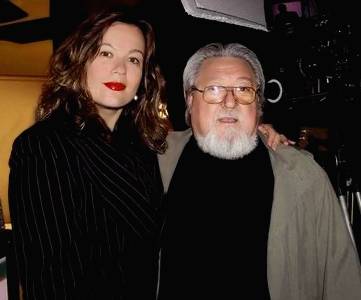« My SDFF - Two Lovers | Main | Coffee Break »
November 22, 2008
My SDFF - Two looks at Eastern Europe, Yesterday and Today
Two final films from the festival, both that look at Eastern Europe, both without distribution at this time, but may be seen at festivals.

Black Sea/Mar Nero
Federico Bondi - 2008
IntraMovies 35mm film
Black Sea is a low key film about an older Italian woman, and her caretaker, a young woman from Romania. Gemma, recently widowed, is hostile towards her son, and hardly hospitable to Angela, a virtual stranger to Italy. In addition to fighting the prejudices of being a foreigner in Italy, Angela finds little solace with members of the Romanian community in Florence, and communications with her boyfriend left behind have collapsed.
Federico Bondi explores the gradual friendship developed by the two different women. As Gemma, Ilaria Occhini becomes younger looking as the film progresses. Romanian actress Dorotheea Petre portrays Angela. The relationship between the two women takes on a fluidity based on respective needs as well as what each is capable of doing to support the other. Angela's uncertainty regarding her relationship with the young man back home, Adrian, motivates the two women to take a trip to Angela's small town in Romania.

As serious as Black Sea may sound from the basic description, Bondi has an eye from some unexpected humor. One such example is the use at one point of this Romanian pop video. There is also the scene stealing performance by Marius Silagiy as Angela's father, a much older man with whose old world charm overcomes any language barriers with Gemma. What makes Silagiy's performance more amazing is to know, as Bondi revealed, that the actor is both blind and deaf, yet still capable of indicating his ability as a veteran comic performer.
Torn from the Flag
Klaudia Kovacs & Endre Hules
Homage to 1956 35mm film
I watched Torn from the Flag as something of a companion piece to the documentary on Lazslo Kovacs and Vilmos Zsigmond. The footage that they shot during the Hungarian revolt of 1956 is used, but also put into the context of Hungarian history and the history of the Cold War. The title refers to the Hungarian flag that had the crest that symbolized Communist rule, torn out to create a hole in the flag, creating an unusual framing device for filming part of the activity on the streets.
Cross cut with the documentary footage is a series of portraits, people who participated in the events, and pundits and historians. Most are trying to make sense of events for the viewers while some appear to be struggling to make sense for themselves. Among the participants is a man who was a political prisoner, with a story of torture so appalling just to imagine. Another man was a member of the Hungarian state police who helped enforce the communist rule, from a peasant family, who saw a role in the military as his only opportunity after World War II.
The documentary footage from Hungary is compelling to watch. Based on what was recorded on film, and how close some of the film students were to the action, the conditions were as perilous than that of any filmmaker caught in a battle zone. Klaudia Kovacs, no relation to Lazslo Kovacs, made the film as a means of preserving the memory of the events of over fifty years ago. While the events were significant to the people involved in the Hungarian revolt, what Torn from the Flag also attempts to explore is how the meaning of those events changed over the years.

Klaudia Kovacs and Lazslo Kovacs
Posted by Peter Nellhaus at November 22, 2008 12:53 AM
